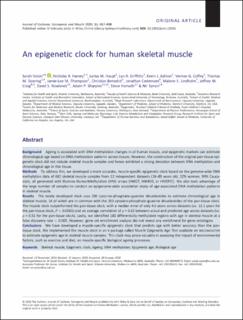| dc.contributor.author | Voisin, Sarah | |
| dc.contributor.author | Harvey, Nicholas R | |
| dc.contributor.author | Haupt, Larisa M | |
| dc.contributor.author | Griffiths, Lyn R | |
| dc.contributor.author | Aston, Kevin J | |
| dc.contributor.author | Coffey, Vernon G. | |
| dc.contributor.author | Doering, Thomas M | |
| dc.contributor.author | Thompson, Jamie-Lee M | |
| dc.contributor.author | Benedict, Christian | |
| dc.contributor.author | Cedernaes, Jonathan | |
| dc.contributor.author | Lindholm, Malene E | |
| dc.contributor.author | Craig, Jeffrey M | |
| dc.contributor.author | Rowlands, David S | |
| dc.contributor.author | Sharples, Adam | |
| dc.contributor.author | Horvath, Steve | |
| dc.contributor.author | Eynon, Nir | |
| dc.date.accessioned | 2021-02-10T11:14:54Z | |
| dc.date.available | 2021-02-10T11:14:54Z | |
| dc.date.created | 2020-02-26T09:52:39Z | |
| dc.date.issued | 2020 | |
| dc.identifier.citation | Journal of Cachexia, Sarcopenia and Muscle. 2020, 11(4), 887-898. | en_US |
| dc.identifier.issn | 2190-5991 | |
| dc.identifier.uri | https://hdl.handle.net/11250/2727162 | |
| dc.description | This is an open access article under the terms of the Creative Commons Attribution License (http://creativecommons.org/licenses/by/4.0/), which permits use, distribution and reproduction in any medium, provided the original work is properly cited. | en_US |
| dc.description.abstract | Background: Ageing is associated with DNA methylation changes in all human tissues, and epigenetic markers can estimate chronological age based on DNA methylation patterns across tissues. However, the construction of the original pan‐tissue epigenetic clock did not include skeletal muscle samples and hence exhibited a strong deviation between DNA methylation and chronological age in this tissue. Methods: To address this, we developed a more accurate, muscle‐specific epigenetic clock based on the genome‐wide DNA methylation data of 682 skeletal muscle samples from 12 independent datasets (18–89 years old, 22% women, 99% Caucasian), all generated with Illumina HumanMethylation (HM) arrays (HM27, HM450, or HMEPIC). We also took advantage of the large number of samples to conduct an epigenome‐wide association study of age‐associated DNA methylation patterns in skeletal muscle. Results: The newly developed clock uses 200 cytosine‐phosphate–guanine dinucleotides to estimate chronological age in skeletal muscle, 16 of which are in common with the 353 cytosine‐phosphate–guanine dinucleotides of the pan‐tissue clock. The muscle clock outperformed the pan‐tissue clock, with a median error of only 4.6 years across datasets (vs. 13.1 years for the pan‐tissue clock, P < 0.0001) and an average correlation of ρ = 0.62 between actual and predicted age across datasets (vs. ρ = 0.51 for the pan‐tissue clock). Lastly, we identified 180 differentially methylated regions with age in skeletal muscle at a false discovery rate < 0.005. However, gene set enrichment analysis did not reveal any enrichment for gene ontologies. Conclusions: We have developed a muscle‐specific epigenetic clock that predicts age with better accuracy than the pan‐tissue clock. We implemented the muscle clock in an r package called Muscle Epigenetic Age Test available on Bioconductor to estimate epigenetic age in skeletal muscle samples. This clock may prove valuable in assessing the impact of environmental factors, such as exercise and diet, on muscle‐specific biological ageing processes. | en_US |
| dc.language.iso | eng | en_US |
| dc.subject | skeletal muscle | en_US |
| dc.subject | epigenetic clock | en_US |
| dc.subject | ageing | en_US |
| dc.subject | DNA methylation | en_US |
| dc.subject | epigenetic age | en_US |
| dc.subject | biological age | en_US |
| dc.title | An epigenetic clock for human skeletal muscle | en_US |
| dc.type | Peer reviewed | en_US |
| dc.type | Journal article | en_US |
| dc.description.version | publishedVersion | en_US |
| dc.rights.holder | © 2020 The Authors. | en_US |
| dc.source.pagenumber | 887-898 | en_US |
| dc.source.volume | 11 | en_US |
| dc.source.journal | Journal of Cachexia, Sarcopenia and Muscle | en_US |
| dc.source.issue | 4 | en_US |
| dc.identifier.doi | 10.1002/jcsm.12556 | |
| dc.identifier.cristin | 1797641 | |
| dc.description.localcode | Institutt for fysisk prestasjonsevne / Department of Physical Performance | en_US |
| cristin.ispublished | true | |
| cristin.fulltext | original | |
| cristin.qualitycode | 1 | |
